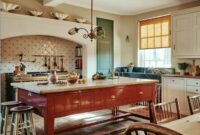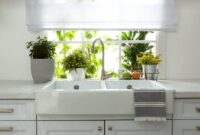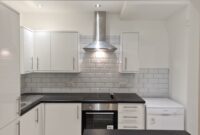Best materials for creating a high-end interior look go beyond mere aesthetics; they represent a fusion of artistry, durability, and sustainability. This exploration delves into the luxurious world of natural stones, exquisite woods, sophisticated metals, and opulent textiles, revealing how each contributes to a truly exceptional living space. We’ll examine the unique properties of each material, explore diverse design applications, and even touch on innovative, eco-conscious options that don’t compromise on style or quality.
Prepare to be inspired by the transformative power of carefully chosen materials.
From the cool elegance of marble to the warm richness of walnut, the choices are vast and the possibilities endless. Understanding the nuances of each material – its durability, maintenance needs, and aesthetic impact – is key to achieving a high-end interior that reflects your personal style and stands the test of time. We’ll guide you through the selection process, offering practical advice and stunning visual examples to help you bring your dream interior to life.
High-End Interior Materials
Natural stone elevates any interior design, offering unparalleled beauty and durability. Its inherent elegance and timeless appeal make it a favorite among high-end designers and homeowners seeking lasting luxury. This section will explore the unique characteristics of marble, granite, and limestone, showcasing their applications and suitability for various interior spaces.
Natural Stone: Marble, Granite, and Limestone
Marble, granite, and limestone each possess distinct visual and tactile qualities that contribute to a high-end aesthetic. Marble, known for its luxurious veining and soft, often cool, feel, brings an air of sophistication. Granite, with its robust texture and wide range of colors and patterns, exudes strength and durability. Limestone, characterized by its subtle tones and often porous surface, offers a more rustic yet refined charm.
The choice depends heavily on the desired aesthetic and the practical considerations of each space.
| Material | Durability | Maintenance | Cost |
|---|---|---|---|
| Marble | Moderate to high (depending on type); susceptible to etching and staining | Regular sealing and cleaning; avoid acidic substances | High to very high |
| Granite | High; very resistant to scratching and staining | Minimal sealing and regular cleaning | Medium to high |
| Limestone | Moderate; susceptible to etching and staining; requires sealing | Regular sealing and cleaning; careful handling to avoid scratches | Medium |
Natural Stone in Interior Spaces
Natural stone finds versatile application in high-end interiors. Flooring, countertops, and wall cladding are prime examples. Marble floors create a sense of grandeur in spacious entryways or living rooms, particularly in classic or neoclassical styles. Granite countertops are a staple in modern and contemporary kitchens, offering both beauty and practicality. Limestone walls add a touch of rustic elegance to bathrooms or dining rooms, complementing farmhouse or Mediterranean styles.
The material’s inherent texture and color variations add depth and visual interest to any room.
Bathroom Designs Featuring Natural Stone
Below are three bathroom design concepts highlighting the unique qualities of different natural stones:
Bathroom Design 1: Marble Masterpiece
This bathroom features Calacatta marble flooring and wall cladding, creating a luxurious and spa-like atmosphere. The veining of the marble is the focal point, enhanced by minimalist fixtures and soft lighting. A large, free-standing soaking tub adds to the sense of opulence. The overall style is classic and elegant.
Bathroom Design 2: Granite Modernity
This contemporary bathroom uses dark grey granite for the countertops and shower surround, contrasting beautifully with crisp white cabinetry and fixtures. The granite’s inherent texture adds a sense of rugged sophistication, while the clean lines of the design maintain a modern feel. The flooring could be a lighter-colored porcelain tile to balance the darker granite.
Bathroom Design 3: Limestone Retreat
This bathroom evokes a rustic yet refined aesthetic with warm-toned limestone walls and flooring. The subtle variations in the stone’s color and texture add visual interest, while the overall palette remains calming and serene. A walk-in shower with a limestone bench adds to the spa-like feel. The style leans towards a farmhouse or Mediterranean aesthetic.
Luxurious Wood Options for High-End Design
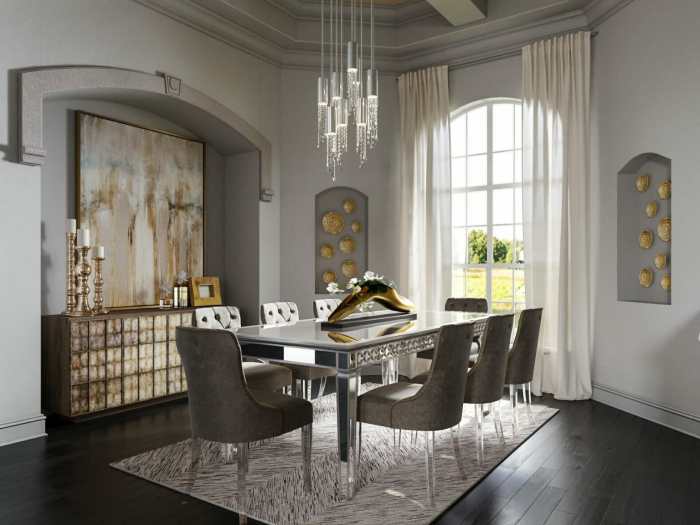
Source: decorilla.com
Choosing the right wood can dramatically elevate the aesthetic and longevity of a high-end interior. The inherent beauty and durability of various wood species offer a wealth of options for creating stunning and lasting design features. From flooring to cabinetry, the selection process should consider not only the visual appeal but also the practical aspects of each wood type.
The following explores several luxurious wood options, comparing their characteristics and highlighting appropriate finishing techniques and design styles.
Walnut, Oak, Mahogany, and Cherry Wood: A Comparison
Understanding the unique characteristics of different wood types is crucial for making informed design decisions. Each species offers a distinct visual impact and level of durability, influencing its suitability for various applications.
- Walnut: Known for its rich, dark brown hues often streaked with lighter browns and purples, walnut possesses a striking, luxurious grain pattern. It’s relatively hard and durable, making it ideal for high-traffic areas like flooring and cabinetry. Its inherent beauty requires minimal embellishment to shine.
- Oak: A classic choice, oak boasts a wide range of colors, from light blonde to reddish-brown, with a prominent, open grain. Its exceptional hardness and durability make it highly resistant to wear and tear. Oak’s versatility allows it to complement both traditional and contemporary styles.
- Mahogany: Renowned for its deep reddish-brown tones and fine, even grain, mahogany exudes elegance and sophistication. This strong, dense wood is highly resistant to decay and insect infestation, making it a premium choice for lasting furniture and paneling. Its rich color often needs minimal finishing to maintain its visual impact.
- Cherry: Cherry wood offers a warm, reddish-brown tone that deepens beautifully with age, developing a rich patina over time. Its medium hardness and relatively fine grain make it suitable for a variety of applications, from flooring to fine cabinetry. It’s less durable than oak or mahogany, but its beauty and ability to age gracefully are highly valued.
Wood Finishing Techniques for Enhanced Richness and Longevity
Proper finishing techniques are essential for protecting and enhancing the natural beauty of high-end wood features. These techniques not only safeguard the wood from damage but also contribute significantly to its overall aesthetic appeal.
Several techniques contribute to a superior finish:
- Oil Finishing: Penetrates the wood, enhancing its natural color and grain while providing a protective layer. It allows the wood to breathe, preventing cracking and warping. Regular reapplication maintains the finish.
- Lacquer Finishing: Creates a hard, durable surface that is highly resistant to scratches and wear. Lacquer offers a smooth, glossy finish that is easy to clean. It is a popular choice for high-traffic areas.
- Urethane Finishing: Provides exceptional durability and protection against moisture and UV damage. Urethane finishes can range from matte to high-gloss, allowing for customization to suit different design styles.
- Wax Finishing: A more traditional method, wax finishing enhances the wood’s natural beauty with a subtle sheen. It provides some protection but requires more frequent reapplication than other finishes.
Wood Types and Finishes in Different Interior Design Styles
The choice of wood and finish significantly impacts the overall aesthetic of an interior design style. Different woods and finishes can be carefully selected to enhance and complement the chosen style.
Examples of wood usage in various design styles:
- Modern Minimalist: Light-colored oak with a matte urethane finish can create a clean, uncluttered look, emphasizing the wood’s natural grain. The simplicity of the wood complements the minimalist aesthetic.
- Traditional: Dark walnut or mahogany with a high-gloss lacquer finish can create a rich, opulent feel, aligning with the classic elegance of traditional design. Intricate detailing in the wood or furniture enhances this style.
- Eclectic: A mix of wood types and finishes can create a unique and personalized space. For example, reclaimed wood with a distressed finish paired with sleek, polished cherry cabinetry can reflect an eclectic blend of styles and textures. The contrast creates visual interest and personality.
High-End Metals and Finishes in Interior Design
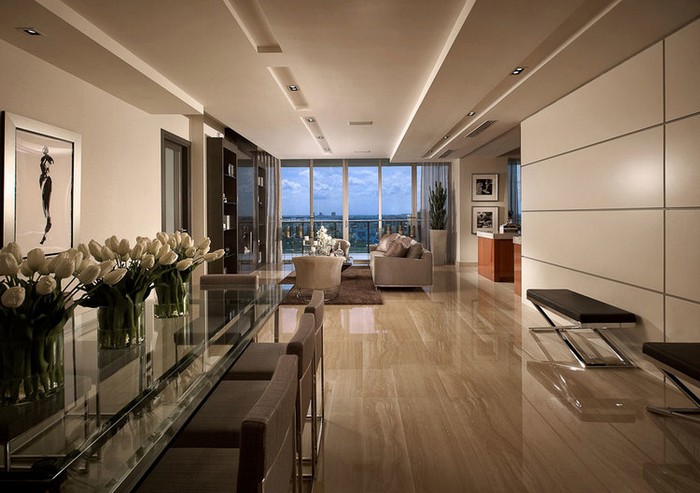
Source: miamidesignagenda.com
The strategic use of metals elevates interior design from merely functional to truly luxurious. Beyond their inherent beauty, metals offer a range of textures and finishes that can dramatically impact the overall mood and sophistication of a space. The careful selection and application of metals are key to achieving a high-end aesthetic.
Metal Properties, Applications, and Maintenance
The choice of metal hinges on its visual appeal, durability, and ease of maintenance. Different metals lend themselves to various applications, requiring different levels of care. The following table summarizes the key properties of popular high-end metals.
| Metal | Properties | Applications | Maintenance |
|---|---|---|---|
| Brass | Warm, golden tone; relatively soft; prone to tarnishing; easily worked. | Lighting fixtures, hardware (door knobs, pulls), decorative accents, plumbing fixtures. | Regular polishing with a brass cleaner to maintain shine; avoid harsh chemicals. |
| Copper | Rich, reddish-brown tone; develops a patina over time; relatively soft; malleable. | Countertops, backsplashes, lighting fixtures, sinks, decorative elements. | Can be polished to maintain its shine or left to develop a natural patina; cleaning with mild soap and water. |
| Stainless Steel | Modern, sleek appearance; durable; resistant to corrosion; easy to clean. | Appliances, kitchen sinks, countertops, backsplashes, hardware. | Easy to clean with mild soap and water; avoid abrasive cleaners. |
| Bronze | Rich, deep brown or reddish-brown tone; develops a patina over time; durable; relatively resistant to corrosion. | Lighting fixtures, sculptures, decorative accents, hardware. | Can be polished or left to develop a patina; cleaning with mild soap and water. |
Metallic Finishes in Lighting, Hardware, and Decor
Metallic finishes significantly impact the overall aesthetic. Brass fixtures can create a warm, inviting ambiance, while stainless steel offers a clean, modern feel. Copper accents introduce a touch of rustic elegance, and bronze lends a sense of timeless sophistication.For instance, a brass chandelier can be a stunning focal point in a dining room, adding a touch of old-world charm.
Stainless steel handles on kitchen cabinets contribute to a sleek, contemporary look. Copper pipes exposed as a design feature in a bathroom can create an industrial-chic aesthetic. Bronze accents in a living room, such as decorative bowls or lamps, add a layer of understated luxury.
Modern Kitchen Design Incorporating Multiple Metals
This modern kitchen design incorporates both stainless steel and brass to achieve a balanced aesthetic. The stainless steel is used for the appliances (refrigerator, oven, dishwasher) and the sink, maintaining a clean and functional look. Brass is used for the faucet, cabinet hardware, and pendant lighting fixtures. This combination creates a sophisticated contrast: the cool, clean lines of the stainless steel are warmed by the rich golden tones of the brass, resulting in a space that is both modern and inviting.
The brass elements add a touch of personality and visual interest, preventing the stainless steel from feeling cold or sterile. The overall effect is a luxurious yet functional kitchen that seamlessly blends modern practicality with a touch of vintage charm.
The Role of Textiles in High-End Interior Design: Best Materials For Creating A High-end Interior Look
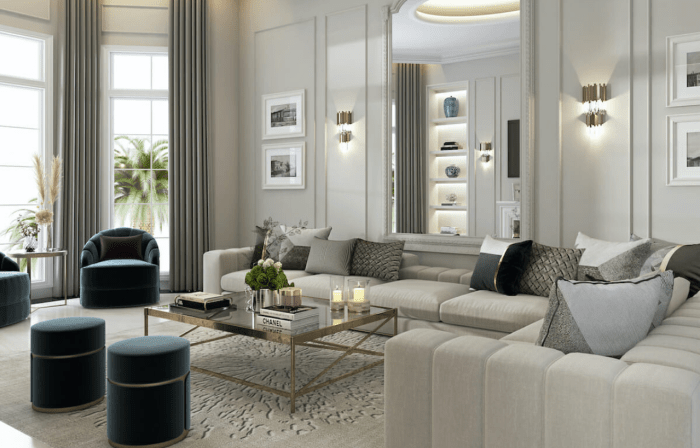
Source: essentialhome.eu
Textiles are the unsung heroes of high-end interior design, adding layers of texture, color, and personality that elevate a space from merely functional to truly luxurious. The careful selection and placement of fabrics dramatically impact the overall feel and aesthetic, contributing significantly to the overall success of a design. Choosing the right textiles is crucial in creating a cohesive and opulent atmosphere.
Comparison of Silk, Linen, Velvet, and Wool Textiles
The choice of textile depends heavily on the desired aesthetic and the practical requirements of the space. Silk, linen, velvet, and wool each offer unique properties that make them suitable for different applications in upholstery and drapery.
| Textile | Texture | Durability | Drape | Suitable Furniture | Suitable Room Types |
|---|---|---|---|---|---|
| Silk | Smooth, lustrous | Delicate, requires careful handling | Fluid, elegant | Accent pillows, drapes, delicate upholstery | Bedrooms, formal living rooms |
| Linen | Slightly rough, natural | Durable, gets softer with age | Relaxed, slightly wrinkled | Sofa upholstery, curtains, bedding | Casual living rooms, kitchens, bedrooms |
| Velvet | Soft, plush | Moderately durable, prone to crushing | Heavy, luxurious | Accent chairs, sofas, drapes | Formal living rooms, theaters, bedrooms |
| Wool | Soft, warm | Durable, resistant to stains | Full, substantial | Sofa upholstery, rugs, throws | Living rooms, bedrooms, dining rooms |
Impact of Textile Patterns and Colors on Room Atmosphere
Textile patterns and colors profoundly influence the mood and ambiance of a room. Bold geometric patterns can create a dynamic and energetic feel, while floral prints can introduce a sense of romance and tranquility. Subdued, neutral colors contribute to a calm and sophisticated atmosphere, whereas vibrant hues can inject energy and excitement. For example, a living room with deep teal velvet sofas and gold patterned cushions would exude a sense of richness and sophistication, while a bedroom adorned with soft pastel linen bedding and delicate floral drapes would create a peaceful and serene haven.
A bold geometric rug in a vibrant color, on the other hand, can serve as a focal point, adding visual interest to a more neutral space.
High-End Textiles in a Cohesive Living Room Design
Imagine a living room designed with a cohesive and luxurious feel using high-end textiles. The space features a plush, oatmeal-colored wool sofa, complemented by a pair of deep emerald green velvet armchairs. These rich textures are balanced by sheer silk drapes in a soft ivory hue, allowing natural light to filter through while maintaining a sense of elegance. A large, intricately patterned silk rug in muted blues and greens anchors the seating area, adding a layer of visual complexity.
Finally, a collection of luxurious silk and wool throw pillows in coordinating colors and textures adds the finishing touch, contributing to the overall sense of opulence and comfort. The interplay of textures – the soft wool, the smooth silk, the plush velvet – creates a multi-sensory experience that elevates the space to a level of true luxury.
Innovative and Sustainable Materials for High-End Interiors
The increasing awareness of environmental concerns is driving a shift towards sustainable practices in all sectors, including interior design. High-end interiors are no longer solely defined by luxury and opulence; sustainability and innovation are becoming integral aspects of discerning design choices. This section explores three innovative and sustainable materials that are transforming the landscape of high-end interior spaces.
These materials offer not only environmental benefits but also unique aesthetic qualities and practical advantages, challenging traditional notions of luxury and demonstrating that sustainability and high-end design are not mutually exclusive.
Recycled Glass, Best materials for creating a high-end interior look
Recycled glass, often overlooked, offers a surprisingly versatile and aesthetically pleasing option for high-end interiors. Its inherent strength, combined with the ability to be formed into various shapes and colors, makes it suitable for countertops, backsplashes, flooring, and even decorative elements. The sustainability benefits are considerable, reducing landfill waste and the energy consumption associated with producing virgin glass. The production process itself is also less energy-intensive than creating new glass from raw materials.
Moreover, the inherent variations in color and texture of recycled glass add a unique character and visual interest that complements many interior design styles, from modern minimalist to rustic chic. The resulting aesthetic is often described as having a sophisticated, industrial-chic feel, which is highly desirable in contemporary high-end design.
Bamboo
Bamboo, a rapidly renewable resource, provides a sustainable alternative to traditional hardwoods in flooring, furniture, and paneling. Its strength-to-weight ratio is exceptional, meaning it can be used in structural applications while maintaining a lightweight feel. Bamboo’s inherent beauty, with its warm tones and distinctive grain patterns, offers a luxurious aesthetic that easily rivals traditional hardwoods. From a sustainability standpoint, bamboo grows quickly and requires minimal resources, making it a highly environmentally responsible choice.
Its inherent resistance to pests and moisture also contributes to its durability and longevity, making it a practical choice for high-end interiors. Furthermore, its versatility in terms of finishes – from natural to stained or lacquered – allows for seamless integration into a wide range of design schemes.
Bio-based Plastics
Bio-based plastics, derived from renewable resources such as corn starch or sugarcane, offer a sustainable alternative to traditional petroleum-based plastics. These materials can be used in a variety of applications, including furniture, lighting fixtures, and even wall coverings. While still a relatively new material in high-end design, bio-based plastics are rapidly evolving, with advancements leading to improved durability and aesthetic appeal.
Their sustainability benefits are substantial, reducing reliance on fossil fuels and minimizing carbon emissions. Furthermore, many bio-based plastics are biodegradable or compostable at the end of their life cycle, minimizing their environmental impact. While the aesthetic appeal might not yet match the visual richness of some traditional materials, advancements in design and manufacturing are continually improving their look and feel, making them increasingly attractive for sophisticated interior spaces.
Comparison of Innovative and Traditional High-End Materials
The following table compares the aesthetic appeal and practicality of the three innovative materials discussed above with traditional high-end options:
This comparison highlights that innovative materials are not simply ‘eco-friendly alternatives’; they offer a compelling blend of sustainability, aesthetics, and practicality, often exceeding traditional options in certain aspects.
| Material | Aesthetic Appeal | Practicality | Sustainability |
|---|---|---|---|
| Recycled Glass | Unique texture, varied colors, industrial-chic | Durable, resistant to heat and scratches | Reduces landfill waste, lower energy consumption |
| Bamboo | Warm tones, distinctive grain, natural elegance | Strong, lightweight, moisture-resistant | Rapidly renewable, low resource consumption |
| Bio-based Plastics | Increasingly sophisticated designs, varied finishes | Durability varies depending on type, lightweight | Reduces reliance on fossil fuels, potential for biodegradability |
| Traditional Hardwoods (e.g., Mahogany) | Rich color, classic elegance, varied grain patterns | Durable, strong, but can be expensive and require maintenance | Slow-growing, deforestation concerns |
| Marble/Granite | Elegant, luxurious, timeless appeal | Durable, heat-resistant, but heavy and can be prone to staining | High energy consumption during extraction and processing |
Sustainable Bedroom Design Concept
This design concept for a bedroom utilizes bamboo flooring and recycled glass accents to minimize environmental impact while maintaining a luxurious feel. The bamboo flooring provides a warm, natural aesthetic and a sustainable alternative to traditional hardwood. Its inherent durability and moisture resistance make it a practical choice for a high-traffic area like a bedroom. Recycled glass is incorporated into the bedside table lamps, adding a unique visual element and highlighting the commitment to sustainable design.
The use of natural textiles, such as organic cotton or linen, for bedding and curtains further enhances the overall eco-conscious design. This approach significantly reduces the carbon footprint of the bedroom compared to a design relying solely on traditional materials, without compromising on the luxury and sophistication of the space. The warm tones of the bamboo and the subtle sparkle of the recycled glass create a calm and inviting atmosphere.
The overall effect is a luxurious yet environmentally responsible bedroom design that showcases the potential of innovative and sustainable materials in high-end interiors.
Wrap-Up
Creating a high-end interior is a journey of discovery, a process of carefully curating materials that speak to your unique vision. By thoughtfully combining natural stones, fine woods, lustrous metals, and luxurious textiles, you can craft a space that is not only beautiful but also functional, durable, and reflective of your personal style. Remember that the best materials are those that resonate with you, creating a haven that is both visually stunning and deeply personal.
Embrace the possibilities, explore the options, and let your creativity flourish in the creation of your exquisite living space.
Clarifying Questions
What’s the best way to clean marble countertops?
Use a soft cloth, warm water, and a mild pH-neutral cleaner. Avoid harsh chemicals and abrasive cleaners.
How can I maintain the shine of hardwood floors?
Regular sweeping or vacuuming, occasional damp mopping, and periodic professional refinishing will help maintain their luster.
Are there any eco-friendly alternatives to leather upholstery?
Yes, consider sustainable fabrics like organic cotton, linen, or recycled materials. Many manufacturers offer vegan leather alternatives made from plant-based materials.
How do I choose the right metal finish for my kitchen hardware?
Consider the overall style of your kitchen and choose a finish that complements your cabinetry and appliances. Brushed nickel and matte black are popular choices for a modern look.
What are the long-term costs associated with high-end materials?
While initial costs are higher, high-end materials often have longer lifespans, reducing the need for frequent replacements and repairs, ultimately offering long-term value.

